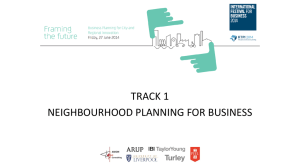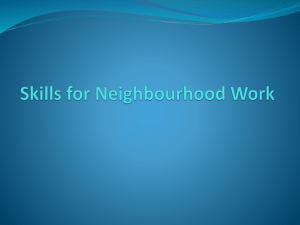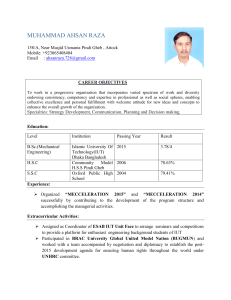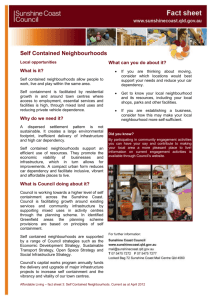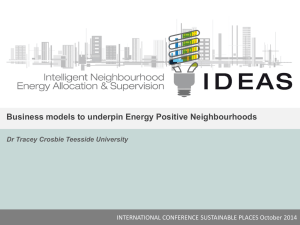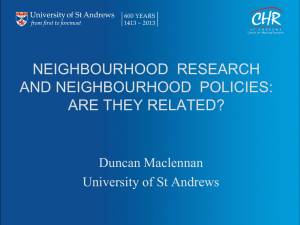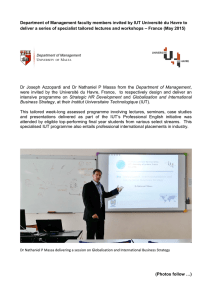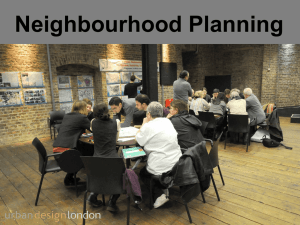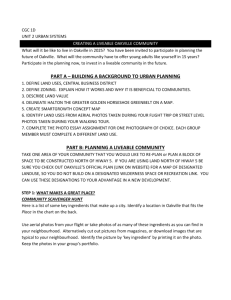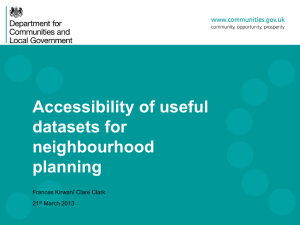Tools to support incremental roll-out of Energy Positive
advertisement
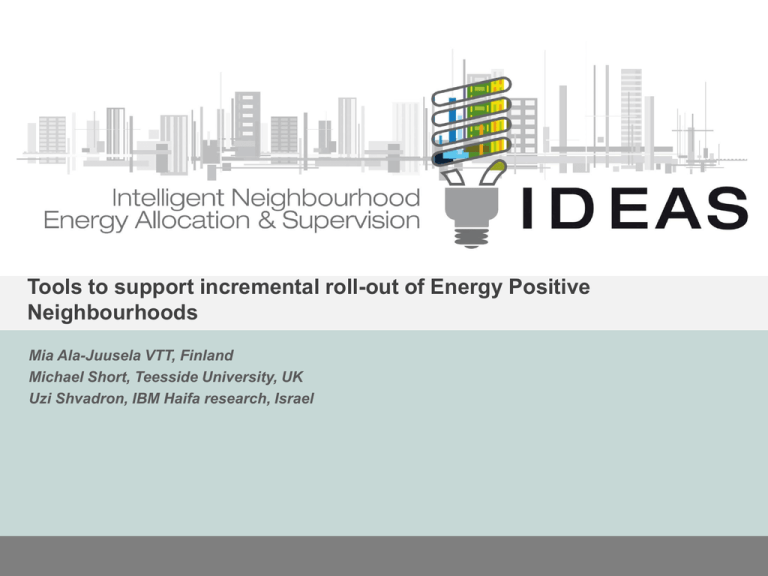
IDEAS Tools to support incremental roll-out of Energy Positive Neighbourhoods Mia Ala-Juusela VTT, Finland Michael Short, Teesside University, UK Uzi Shvadron, IBM Haifa research, Israel IDEAS project IDEAS • The IDEAS project aims to illustrate how communities, public authorities and utility companies across the EU can be engaged in the development and operation of energy positive neighbourhoods (EPN) and the economic and environmental benefits of doing so. • IDEAS will demonstrate how energy positive neighbourhoods can be cost effectively and incrementally implemented by designing, testing and validating: – a neighbourhood energy management tool to optimise energy production and consumption; – user interfaces that engage communities and individuals in the operation of energy positive neighbourhoods; – a decision support urban planning tool to optimise the planning of neighbourhood energy infrastructures; – business models to underpin energy positive neighbourhoods that engage end users, public authorities and utility companies. IDEAS Partners IDEAS Teesside University UK Project Coordinator Technical Research Centre of Finland Centre Scientifique et Technique du Bâtiment, France IBM Israel Science & Technology Ltd Israel Compagnie IBM France SA France NOBATEK France Porvoon kaupunki Finland Porvoon Energia Oy Finland 3 What is an EPN? IDEAS • Definition by IDEAS consortium: “In an Energy Positive Neighbourhood (EPN) the annual energy demand is lower than annual energy supply from local renewable energy sources. Shortterm imbalances in energy supply and demand are corrected with national energy supplies.” “The aim is to provide a functional, healthy, user friendly environment with as low energy demand and little environmental impact as possible. “ Intended users for the tools? IDEAS • An analysis of the user requirements for stakeholders in an Energy Positive Neighbourhood was conducted in beginning of the project, and the development of the tools and user interfaces are based on this analysis. • They are also the starting point for the business model development. • The primary intended user of the tools developed in the IDEAS project is a new type of actor, the energy positive neighbourhood service provider (EPNSP) The concept of an EPNSP IDEAS IDEAS Real-time energy management – ICT infrastructure IDEAS Real-time energy management - Optimisation and support tool IDEAS User interfaces - Home Energy Awareness application IDEAS • To enable the residents in an EPN to contribute to meeting collective neighbourhood energy positive consumption and production goals. • They will not necessarily want to partake in micro energy trading deals, but may be willing to shift their patterns of usage in some cases if they are informed in simple terms that there is an excess or deficit of energy. • Energy feedback by using real-time augmented reality technology on hand-held see-through video to give alerts, interact with users and allow them to visualise real-time energy usage of various energy consumption appliances in the home. • An application that runs on a handheld device will show the resident the saving potential of these home appliances and the potential actions that one can take. User interfaces - 3D virtual site • User interface based on mixed reality technology that share publicly accessible 3D virtual space, representing a replica of the IUT demonstration site in Bordeaux, France • Enables remote users to access the IUT site from anywhere in the world, to be hosted by a local (virtual) person (avatar), and to learn about energy consumption and production options in the site without actually visiting it • Involving students: includes also the ability of IUT students to enhance the 3D IUT virtual world with new features and virtual information IDEAS User interfaces - Energy awareness screens IDEAS • Public screen displays for both demo sites • Residents on the Finnish demo site want to be aware of their local neighbourhood energy production/consumption state so that they can contribute their share towards meeting the collective neighbourhood energy positive consumption and production goals. • Current and historical energy consumption for their neighbourhood • Also helps the IDEAS project and the City of Porvoo to promote EPN to residents • Similar information to IUT users. Outline of the decision support tool (AtLas) IDEAS Next steps • The tools have been developed according to the specifications. • The implementation to the demo sites is being finalised. • The tools will be demonstrated at two sites: – part of a University campus in Bordeaux (IUT), France – a newly built residential area (Omenatarha) in Porvoo, Finland. IDEAS IDEAS Thank you www.ideasproject.eu info@ideasproject.eu Acknowledgements The IDEAS Collaborative Project (Grant Agreement No. 600071) is co-funded by the European Commission, Information Society and Media Directorate-General, under the Seventh Framework Programme (FP7), Cooperation theme three, “Information and Communication Technologies” 15
